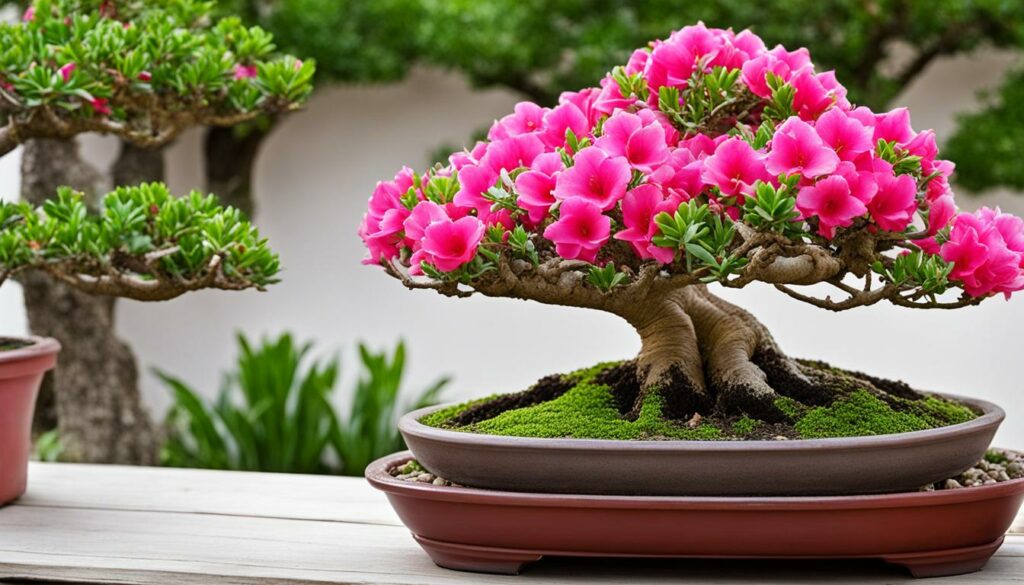If you’re a bonsai enthusiast looking for a captivating, visually stunning tree with fascinating characteristics, look no further than Adenium bonsai. Also known as the Desert Rose, Adenium is a succulent bonsai species that’s unique in many ways. In this article, we’ll explore the origins, characteristics, care requirements, and shaping and training techniques for Adenium bonsai trees, so you can elevate your bonsai garden with this beautiful and distinctive species.
Key Takeaways
- Adenium bonsai, also known as the Desert Rose, is a succulent bonsai species with sculptural beauty and fascinating features.
- Adenium bonsai is native to arid regions of Africa and the Arabian Peninsula and has adapted to harsh desert environments.
- Proper care techniques such as pruning, watering, providing adequate sunlight and temperature conditions, and protecting against pests and diseases are essential for Adenium bonsai.
- Adenium bonsai offers a world of creative possibilities when it comes to shaping and training, and its beauty and allure make it a captivating centerpiece for your bonsai garden.
- Adenium bonsai holds a rich symbolic and spiritual meaning in various cultures and can be a meaningful expression of creativity and mindfulness.
The Origins and Characteristics of Adenium
Adenium bonsai, also known as Desert Rose bonsai, is a succulent species native to arid regions of Africa and the Arabian Peninsula. This unique bonsai has adapted to survive in harsh desert conditions, which is why it is known for its thick, fleshy stems that store water.
Adenium bonsai is a visually attractive species due to its beautiful and vibrant flowers. These blossoms appear in various colors, including pink, red, white, and yellow. The Adenium flowers are strikingly similar to those of the Frangipani tree, to which it is related.
The Adenium can bloom year-round, but the best bloom time is in late winter and early spring. Many bonsai enthusiasts appreciate Adenium because their unusual flower shapes and bright colors are captivating.
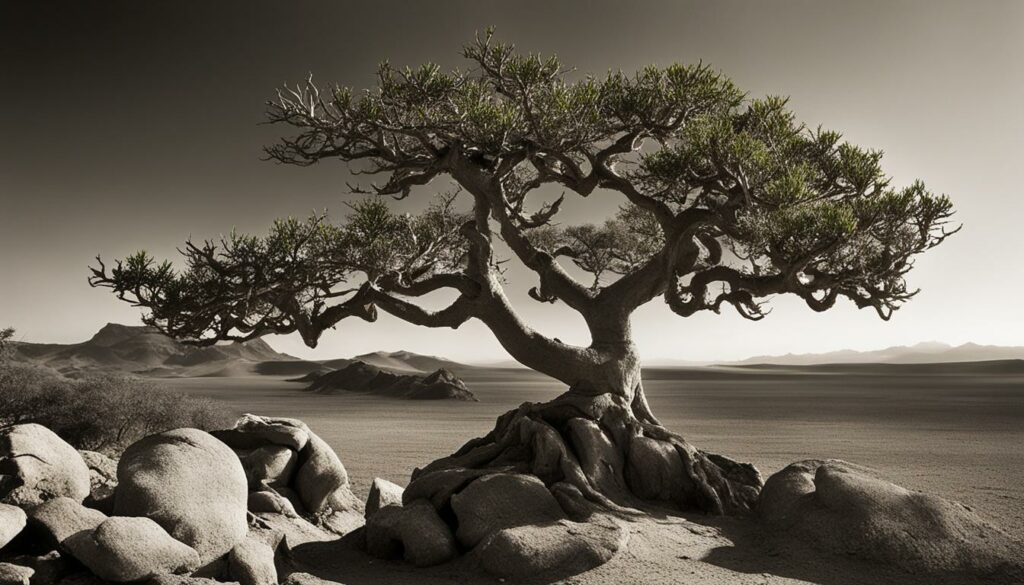
Furthermore, Adenium bonsai is easy to cultivate indoors or outdoors using the appropriate techniques. The Desert Rose bonsai can be grown to heights ranging from 3 to 10 feet, depending on the cultivar and care provided.
Overall, Adenium bonsai is an excellent species for bonsai enthusiasts due to its adaptability, striking physical features, and blooming capacity. In the following sections, we will learn more about how to care for and shape this beautiful and unique bonsai.
Creating and Caring for Adenium Bonsai
Adenium bonsai requires specific care to thrive and flourish. Whether you are a novice or experienced gardener, it is crucial to understand the proper techniques for maintaining your Adenium bonsai tree. By following these care guidelines, you can ensure that your bonsai remains healthy and beautiful for years to come.
Pruning
Pruning is an essential aspect of Adenium bonsai care. To encourage new growth and maintain the desired shape of your bonsai, you will need to prune it regularly. When pruning, use sharp, clean tools to avoid damaging your tree. Cut back branches and stems, keeping in mind the overall shape of your bonsai. Regular pruning will help to improve the overall health and appearance of your Adenium bonsai.
Watering
Proper watering is crucial for the health of your Adenium bonsai. Overwatering can lead to root rot, while underwatering can cause your tree to dry out and wither. Water your bonsai thoroughly, ensuring that the soil is damp but not waterlogged. Use a well-draining soil mix to prevent water from pooling around the roots. Water your Adenium bonsai only when the soil has dried out completely.
Sunlight and Temperature
Adenium requires bright, direct sunlight for at least six hours per day. Ensure that your bonsai is placed in a location where it can receive plenty of sunshine. During the winter months, when the temperature drops below 50°F (10°C), move your Adenium bonsai indoors to prevent cold damage. Keep your bonsai in a warm, humid location away from drafts and cold air.
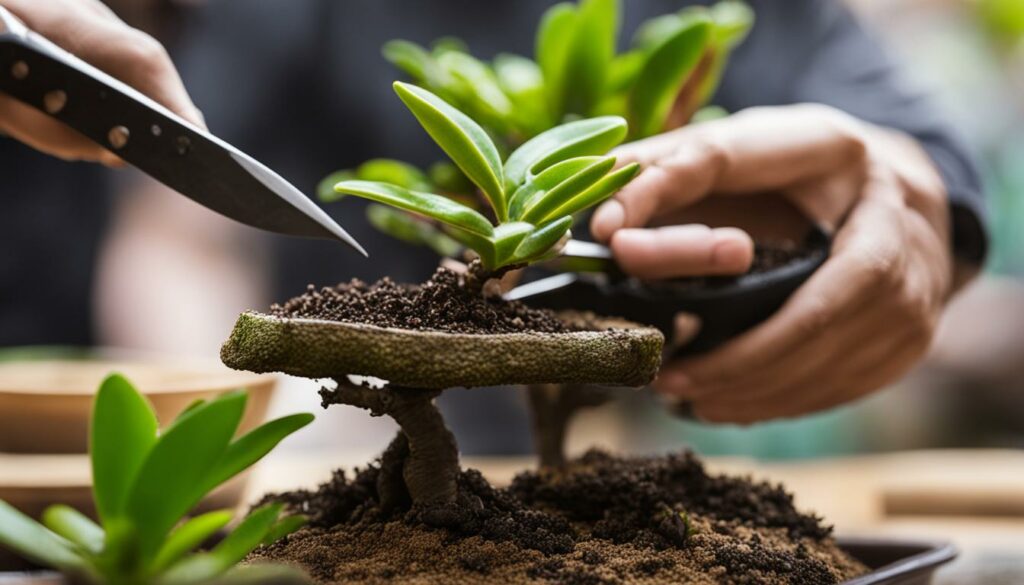
“Proper care for Adenium bonsai is essential to maintain its unique beauty and ensure its longevity.”
By following these Adenium bonsai care guidelines, you can keep your tree healthy and thriving. Regular pruning, proper watering, and suitable sunlight and temperature conditions will help maintain the beauty and vitality of your Adenium bonsai for years to come.
Shaping and Training Adenium Bonsai
Adenium bonsai is an excellent choice for bonsai enthusiasts who enjoy shaping and training their trees to achieve unique styles. With its thick stems and vibrant flowers, Adenium has many opportunities for creative expression. Whether you prefer traditional formal upright or cascading styles, or want to experiment with more modern designs, Adenium bonsai shaping offers endless possibilities.
To get started, it’s essential to understand the techniques involved in shaping and styling your Adenium bonsai. One popular method is wiring, which involves wrapping a thin copper or aluminum wire around the stem and gently bending it into the desired shape. It’s essential to check the wire regularly to ensure it isn’t damaging the tree or causing injury. Another technique is pruning, which involves removing unwanted branches to promote a fuller, more balanced tree structure. You can use a combination of wires and pruning to achieve your desired aesthetic.
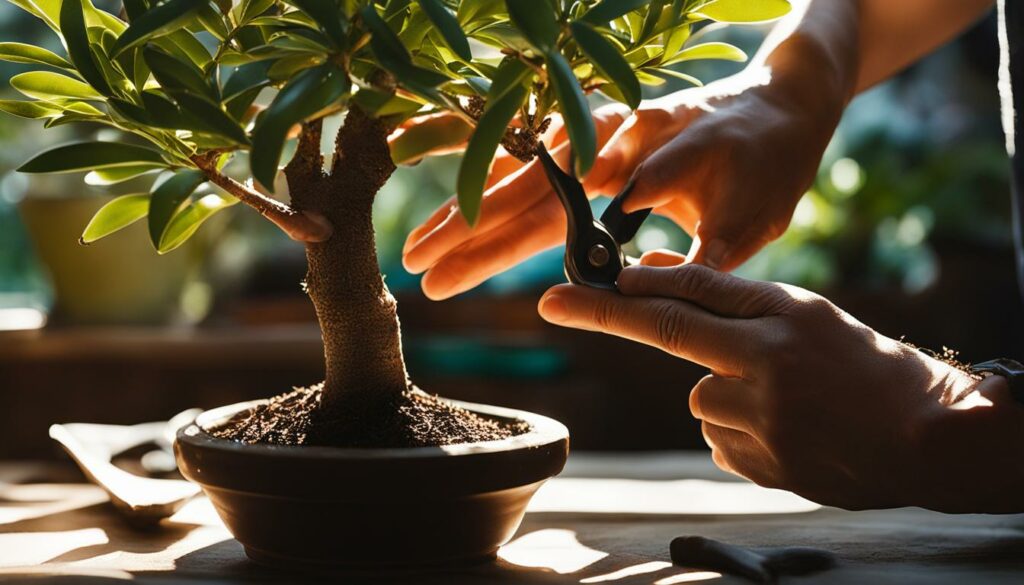
When training your Adenium bonsai, it’s essential to consider the plant’s natural growth patterns and adjust your methods accordingly. For example, Adenium often grows with an irregular trunk and branching pattern, which can make it challenging to achieve a formal upright style. Instead, you may want to embrace the natural characteristics of your Adenium and create a unique and individual design.
Training Techniques for Adenium Bonsai
Here are some popular shaping and training techniques for Adenium bonsai:
| Technique | Description |
|---|---|
| Broom Style | This style involves pruning the branches into a ball shape, giving the appearance of a natural broom. |
| Cascade Style | This style involves training the branches to cascade down below the pot’s rim, creating the appearance of a waterfall. |
| Formal Upright Style | This style involves training the trunk to grow upward at a 90-degree angle from the soil and removing any lateral branches to create a tapered trunk. |
| Multiple Trunk Style | This style involves allowing multiple trunks to grow from the soil, creating the appearance of a forest or grove. |
| Slanting Style | This style involves training the trunk to grow at an angle from the soil, creating a dynamic and visually engaging design. |
By experimenting with these techniques and utilizing your own creativity, you can create a one-of-a-kind Adenium bonsai that reflects your personal taste and style.
Pruning and Defoliating Adenium Bonsai
Pruning and defoliating are essential in maintaining the health and shape of your Adenium bonsai. To ensure proper pruning, it is crucial to identify the appropriate time and technique to prune your Adenium bonsai.
When pruning, it is necessary to remove dead branches and growth that is not in harmony with the overall shape of the tree. For Adenium bonsai, the best time to prune is in early spring before the growing season. You should also prune after the flowering season to encourage bushier growth.
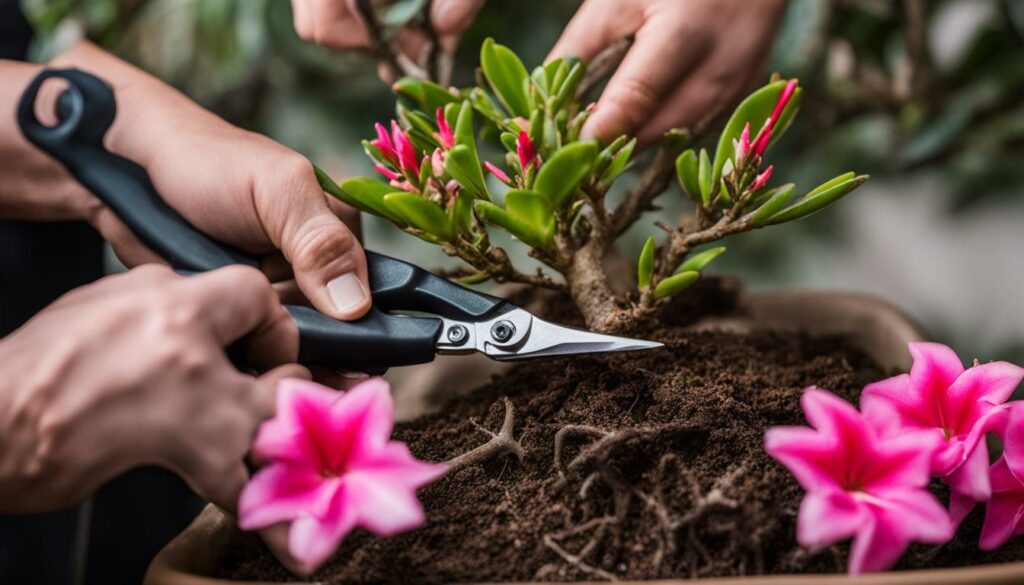
Defoliation, on the other hand, is the process of removing leaves to address issues like pests, disease, or to improve ramification and branch thickness. It is important to defoliate only healthy trees and only in suitable seasons. For Adenium bonsai, July is the ideal time for defoliation.
Remember that pruning and defoliation may prompt your Adenium bonsai tree to produce new growth, so make sure to provide adequate care, including proper watering, fertilizing, and providing optimal lighting conditions well-suited for its growth.
Protecting Adenium Bonsai from Pests and Diseases
Adenium bonsai, like any other bonsai tree, is susceptible to pests and diseases. The most common pests that can infect your Adenium bonsai are spider mites, mealybugs, and scale insects. These pests are attracted to the sap that is present in the bonsai tree, which is necessary for its health and growth. The most common diseases that can affect your Adenium bonsai include root rot, stem rot, and leaf spot diseases.
To protect your Adenium bonsai from pests and diseases, it is important to implement proper pest control and disease prevention measures. One effective method is to regularly inspect your bonsai tree for any signs of infestation or infection. This will help you catch any potential issues early and prevent them from spreading.
Another way to prevent pests and diseases is to ensure that your bonsai tree is properly cared for. Adenium bonsai requires the right balance of water, light, and nutrients to promote healthy growth and prevent stress. Over-fertilizing and overwatering can weaken your bonsai tree, making it more susceptible to pests and diseases.
When dealing with pests and diseases, it’s important to use the right approach for each specific issue. For pests, you can use organic pest control solutions such as neem oil or insecticidal soap. For diseases, it may be necessary to prune affected branches or leaves and apply a fungicide to prevent further spread.
Overall, by implementing proper pest control and disease prevention measures, you can ensure the longevity and vitality of your Adenium bonsai. Regular care and attention will keep your bonsai tree healthy and free from pesky pests and harmful diseases.
Displaying Adenium Bonsai in Your Garden
Adenium bonsai is a stunning addition to any garden and displaying it in the right way can make all the difference. Here are some tips to showcase its unique sculptural beauty:
Pick the Right Pot
The right pot can elevate the overall visual appeal of your Adenium bonsai. Go for a pot that is slightly bigger than the root ball of your bonsai tree and complements its natural coloring. Terra cotta pots look great with the earthy colors of Adenium, while glazed or ceramic pots can provide a pop of color.
Choose the Right Stand
When it comes to stands, there are many options available. A simple wooden stand can provide a minimalist look, while metal stands can provide a modern and contemporary feel. Make sure the stand is sturdy and complements the overall style of your garden.
Positioning for Maximum Visual Appeal
The right positioning can enhance the visual appeal of Adenium bonsai. Place it in a spot that receives adequate sunlight and provides good airflow. Consider positioning it against a neutral background, such as a wall or fence, to ensure its unique features stand out.
By following these tips, your Adenium bonsai will become an eye-catching centerpiece in your garden.
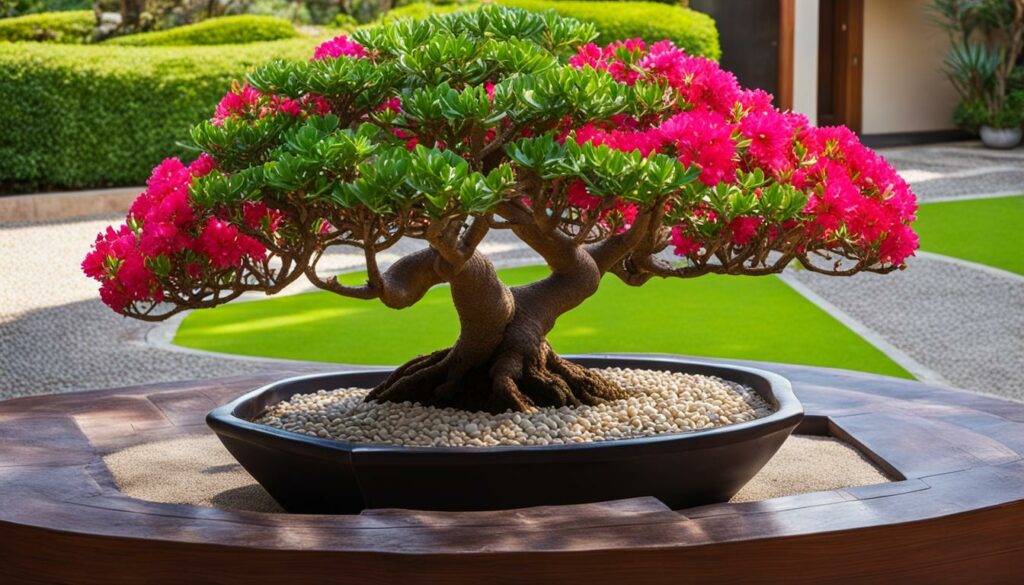
Propagating and Repotting Adenium Bonsai
Propagating and repotting are essential aspects of maintaining the health and longevity of your Adenium bonsai. Whether you want to expand your existing collection or share the beauty of Adenium bonsai with others, we will guide you through the process.
Propagating Adenium Bonsai
If you’re interested in propagating your Adenium bonsai, there are several techniques to consider, including root cuttings, air layering, and grafting. Root cuttings involve removing a section of the Adenium roots and repotting it. Air layering involves sealing a section of the Adenium stem to encourage the growth of roots. Grafting involves combining the Adenium plant with another plant to produce a new hybrid. Choose the technique that works best for you and your bonsai gardening goals.
Repotting Adenium Bonsai
Repotting your Adenium bonsai is essential to ensure optimal root health and overall growth. You should repot your Adenium bonsai every 2-3 years, using well-draining soil and a larger pot than the previous one. Be gentle when removing the old soil and trimming the roots, as Adenium has a sensitive root system. After repotting, water your Adenium bonsai thoroughly and place it in a partially shaded area for a few days.
Succulent Bonsai Maintenance
Proper maintenance of your Adenium bonsai is crucial for its well-being. To maintain its succulent nature, it’s essential to provide it with well-draining soil and avoid overwatering. Adenium should be watered only when the soil is dry to the touch, and you should avoid waterlogging the pot. Additionally, make sure to provide your Adenium bonsai with plenty of sunlight and adequate temperature conditions to encourage optimal growth.
Adenium Bonsai as a Symbolic and Spiritual Art
Adenium bonsai is not just a decorative plant, but it also carries symbolic and spiritual meanings. The Desert Rose bonsai is associated with love, beauty, and purity in some cultures, making it a popular gift for loved ones on special occasions.
The succulent bonsai is also believed to have healing properties, both physically and mentally. Its bright and uplifting blooms are said to bring positive energy, while the act of cultivating the Adenium bonsai can promote mindfulness and reduce stress.
“The art of bonsai represents the perfect harmony between man and nature.”
The cultivation of Adenium bonsai is not just a hobby but a form of art and self-expression. It requires patience, dedication, and an appreciation for the natural world. The meditative practice of shaping and nurturing the bonsai tree is a way to connect with nature and find inner peace.
By integrating Adenium bonsai into your living space, you can create an atmosphere of tranquility and beauty. The Desert Rose bonsai’s graceful form and delicate flowers are a reminder of the impermanence of life and the importance of appreciating each moment.
The Spiritual Meaning of Adenium Bonsai in Different Cultures
| Culture | Symbolic Meaning |
|---|---|
| Thailand | The Adenium bonsai is associated with love and romance. It is believed that the flowers have the power to rekindle lost love. |
| Shintoism (Japan) | The Desert Rose bonsai is revered as a symbol of love, passion, and vitality. It is often gifted to newlyweds to represent a prosperous and enduring relationship. |
| Buddhism (China) | The succulent bonsai represents a harmonious balance between nature and man. Its gentle and calming presence is believed to bring tranquility and peace of mind to those who cultivate it. |
The spiritual meaning of Adenium bonsai may vary across different cultures, but its significance as a source of beauty, connection, and mindfulness remains the same. Incorporating this unique bonsai tree into your home or garden can bring joy, inspiration, and a deeper sense of purpose to your life.
The Enduring Beauty of Adenium Bonsai
As you gaze upon your Adenium bonsai, you cannot help but marvel at its unique beauty and allure. The Desert Rose bonsai boasts a sculptural elegance that is unmatched by other bonsai tree species. Its thick, fleshy stems, and vibrant flowers imbue it with a mesmerizing aesthetic that is sure to captivate and delight.
The succulent bonsai features a variety of shapes and styles, from the traditional formal upright to more modern designs and abstract styles. Whatever your preference, Adenium bonsai can showcase an alluring aesthetic that evokes a sense of surreal enchantment.
Incorporating Adenium bonsai into your garden can elevate the visual appeal of your space and provide a source of tranquil inspiration. Whether you choose to display it prominently or incorporate it into a more complex arrangement, Adenium bonsai’s allure is sure to enchant you and your guests.
The unique blend of natural beauty and artistic expression that Adenium bonsai brings to your garden is truly the hallmark of its enduring appeal. Its intriguing aesthetics and captivating charm are sure to leave a lasting impression, and you will undoubtedly find yourself drawn to this delightful bonsai tree species time and again.
As you continue your bonsai journey, let Adenium bonsai be a source of inspiration and artistic expression. Its enduring beauty and allure will continue to captivate and enchant you for years to come.
Embrace the allure of Adenium bonsai as you cultivate your masterpiece and experience the meditative qualities of this remarkable succulent bonsai.
FAQ
What is Adenium bonsai?
Adenium bonsai, also known as the Desert Rose bonsai, is a unique succulent bonsai tree that is prized for its sculptural beauty and fascinating characteristics.
Where is Adenium bonsai native to?
Adenium bonsai is native to arid regions of Africa and the Arabian Peninsula, where it has adapted to survive in harsh desert environments.
How do I care for Adenium bonsai?
Proper care for Adenium bonsai involves techniques such as pruning, watering, and providing the necessary sunlight and temperature conditions. It is important to follow specific care guidelines to ensure the long-term health and vitality of your Adenium bonsai.
Can I shape and train Adenium bonsai?
Yes, Adenium bonsai can be shaped and trained using various techniques and methods. Whether you prefer a traditional formal upright style or want to experiment with more modern designs, there are expert tips available to help you achieve your desired aesthetic.
When should I prune and defoliate my Adenium bonsai?
Pruning and defoliating are crucial for maintaining the health and shape of your Adenium bonsai. It is important to understand the appropriate times and techniques for pruning branches and leaves in order to encourage better growth patterns and maintain overall balance and harmony.
How do I protect Adenium bonsai from pests and diseases?
Adenium bonsai, like any other bonsai tree, is susceptible to pests and diseases. This section will identify common pests and diseases that may affect your Adenium bonsai and provide effective methods to prevent and control them. Implementing proper pest control and disease prevention measures will ensure the longevity and vitality of your bonsai tree.
How can I display my Adenium bonsai?
Adenium bonsai can be a stunning centerpiece in your bonsai garden or a unique addition to your collection. This section will provide insights on how to display your Adenium bonsai to highlight its sculptural beauty and create an aesthetically pleasing arrangement. Explore various pots, stands, and placement options to enhance the overall visual impact of your bonsai tree.
Can I propagate and repot Adenium bonsai?
Yes, if you wish to expand your collection or share the beauty of Adenium bonsai with others, this section will guide you through the process of propagating your bonsai tree. Additionally, we will discuss when and how to repot your Adenium to ensure optimal root health and overall growth. Proper propagation and repotting techniques are essential for the long-term success of your Adenium bonsai.
What is the symbolic and spiritual meaning of Adenium bonsai?
Adenium bonsai holds a rich symbolic and spiritual meaning in various cultures. Discover the deeper connections between nature, mindfulness, and the meditative practice of cultivating Adenium bonsai as a form of art and expression.
What is the enduring beauty of Adenium bonsai?
In this final section, we reflect on the enduring beauty of Adenium bonsai and its ability to captivate with its unique charm and allure. By incorporating Adenium into your bonsai garden, you can cultivate a masterpiece that combines nature’s artistry with your own creativity, embracing the aesthetic appeal and meditative qualities of Adenium bonsai.
